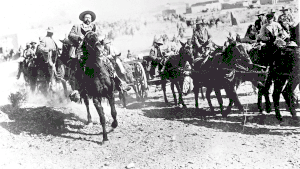
Francisco "Pancho" Villa was a Mexican revolutionary general and one of the most prominent figures of the Mexican Revolution.

The Pancho Villa Expedition—now known officially in the United States as the Mexican Expedition, but originally referred to as the "Punitive Expedition, U.S. Army"—was a military operation conducted by the United States Army against the paramilitary forces of Mexican revolutionary Francisco "Pancho" Villa from March 14, 1916, to February 7, 1917, during the Mexican Revolution of 1910–1920.

The Battle of Carrizal occurred on the June 21, 1916. It was a major skirmish between United States Army troops of General John J. Pershing's Punitive Expedition and Carrancista troops fought at the town of Carrizal in the Mexican state of Chihuahua.

The Apache Scouts were part of the United States Army Indian Scouts. Most of their service was during the Apache Wars, between 1849 and 1886, though the last scout retired in 1947. The Apache scouts were the eyes and ears of the United States military and sometimes the cultural translators for the various Apache bands and the Americans. Apache scouts also served in the Navajo War, the Yavapai War, the Mexican Border War and they saw stateside duty during World War II. There has been a great deal written about Apache scouts, both as part of United States Army reports from the field and more colorful accounts written after the events by non-Apaches in newspapers and books. Men such as Al Sieber and Tom Horn were sometimes the commanding officers of small groups of Apache Scouts. As was the custom in the United States military, scouts were generally enlisted with Anglo nicknames or single names. Many Apache Scouts received citations for bravery.
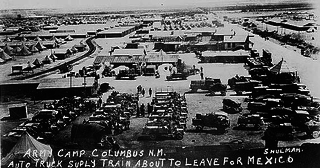
The Village of Columbus and Camp Furlong is a National Historic Landmark District commemorating the 1916 raid by Pancho Villa on the town of Columbus, New Mexico, and the American military response to that raid, the "Punitive Expedition" led by General John J. Pershing. The raid and its response, set during World War I, the Mexican Revolution, and an accompanying low-level Border War, played a significant role in diplomacy and military preparedness for eventual American entry in the World War. The district encompasses buildings which survived the raid, and military facilities used in the American response. The landmark designation was made in 1975.

The Battle of Columbus, March 9, 1916, began as a raid conducted by Pancho Villa's Division of the North on the small United States border town of Columbus, New Mexico, located 3 miles (4.8 km) north of the border with Mexico. The raid escalated into a full-scale battle between Villistas and the United States Army.
Julio Cárdenas was a captain in Pancho Villa's Villista military organization. He was second-in-command to Villa and the head of his personal bodyguard. The Battle of Columbus, New Mexico, in which 18 Americans were killed, sparked the campaign, led by General John J. Pershing, to eradicate Villa's organization.

The Second Battle of Agua Prieta, 1 November 1915, was fought between the forces of Pancho Villa and those of the future President of Mexico, Plutarco Elías Calles, a supporter of Venustiano Carranza, at Agua Prieta, Sonora, as part of the Mexican Revolution. Villa's attack on the town was repulsed by Calles. The battle helped to establish Carranza's control over Mexico and directly led to his becoming, with United States recognition, president. Villa believed that Calles had received tactical and strategic support from the United States since the town is located across the border from Douglas, Arizona and launched his raid on Columbus, New Mexico partly as a reprisal.
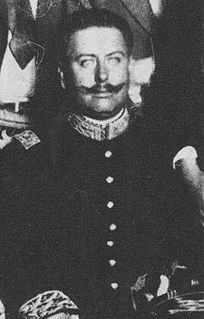
General Jacinto Blas Treviño González was a Mexican military officer, noteworthy for his participation in the Mexican Revolution of 1910 to 1921.

The First Battle of Tijuana was an early engagement of the Mexican Revolution and the first significant victory for the Magonistas. Tijuana was captured and held by rebel forces on May 9, 1911 and was used as a haven for recruiting American volunteers from California.

The Mexican Border War, or the Border Campaign, refers to the military engagements which took place in the Mexico–United States border region of North America during the Mexican Revolution. It was the fifth and final major conflict fought on American soil, where its predecessors were the American Revolutionary War, War of 1812, Mexican–American War and the American Civil War. The end of the Mexican Revolution on 1 December 1920, marked the close of the American Frontier. The Bandit War in Texas was part of the Border War. From the beginning of the Mexican Revolution in 1910, the United States Army was stationed in force along the border and on several occasions fought with Mexican rebels or federals. The height of the conflict came in 1916 when revolutionary Pancho Villa attacked the American border town of Columbus, New Mexico. In response, the United States Army, under the direction of General John J. Pershing, launched an expedition into northern Mexico, to find and capture Villa. Although Villa was not captured, the US Army found and engaged the Villista rebels, and in killing Villa's two top lieutenants. The revolutionary himself escaped and the American army returned to the United States in January 1917. Conflict at the border continued, however, and the United States launched several additional, though smaller operations into Mexican territory until after the American victory in the Battle of Ambos Nogales, leading to the establishment of a permanent border wall. Conflict was not only subject to Villistas and Americans; Maderistas, Carrancistas, Constitutionalistas and Germans also engaged in battle with American forces during this period.

The Battle of Parral, on April 12, 1916, was the first battle between soldiers of Venustiano Carranza, known as Carrancistas, and the United States military during the Mexican Expedition. When a small force of American cavalry was leaving the city of Parral, in the Mexican state of Chihuahua, a superior force of Carrancista soldiers attacked which resulted in a bloody running engagement. Using a strategy of organized withdrawal, the Americans were able to repulse the Mexican attacks and safely escape to the fortified village of Santa Cruz de Villegas.

Brigadier General George Allan Dodd was an officer in the United States Army. He was known for his victory over the Villistas in 1916 at the Battle of Guerrero, Mexico, during the Pancho Villa Expedition.
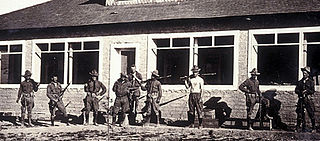
The raid on Glenn Springs occurred on the night of May 5–6, 1916, when Mexican Villistas and Carrancistas attacked the towns of Boquillas and Glenn Springs, Texas. In Glenn Springs, the raiders burned several buildings and fought a three-hour battle with a small force of American soldiers who were stationed there. At the same time, a second party of rebels robbed a general store and a silver mine in Boquillas. Four Americans were killed and the rebels took two hostages to Coahuila. In response to the attack, the United States Army launched a short punitive expedition into Mexico, fought with the rebels, and rescued the captives.

The Second Battle of Nogales was a three-sided military engagement of the Mexican Revolution, fought in November 1915 at the border towns of Nogales, Sonora, and Nogales, Arizona. On the morning of November 26, rebel forces of Pancho Villa, who occupied Nogales, Sonora, began firing on United States Army soldiers in Nogales, Arizona. The Americans responded with counter fire for over two hours before a force of Carrancistas arrived to attack the Villistas. Later that day, the Constitutionalistas accidentally opened fire on American soldiers and another short skirmish was fought. The battle resulted in the deaths of several Mexicans and was the first significant engagement fought between Villistas and the United States military.

The Third Battle of Ciudad Juarez, or simply the Battle of Juarez, was the final major battle involving the rebels of Francisco "Pancho" Villa. It began on June 15, 1919, when Villa attempted to capture the border city of Ciudad Juarez from the Mexican Army. During the engagement the Villistas provoked an intervention by the United States Army protecting the neighboring city of El Paso, Texas. The Americans routed the Villistas in what became the second largest battle of the Mexican Revolution involving the US, and the last battle of the Border War. With the American army closing in, the Villistas had no choice but to retreat. Pancho Villa then attacked Durango but lost again, so he retired to his home at Parral, Chihuahua in 1920, with a full pardon from the Carrancista government.

The Nevill Ranch raid occurred on the night of March 25, 1918 and was the last serious attack on a Texas ranch by Mexican rebels during the Bandit War. Though it is not certain, there was reason to believe that Villistas were responsible for the raid in which two people were murdered. Afterwards, the rebels withdrew to the village of Pilares, Chihuahua under pursuit by a cavalry of American soldiers. A small battle was fought at Pilares on the following day, several more people were killed, and the Americans burned the village before they returned to Texas.
The Raid onSan Ygnacio refers to a battle fought on June 15, 1916 between the United States Army and Mexican raiders near the border town of San Ygnacio, Texas. Three different Mexican factions were known to have launched raids into Texas at the time but most of the evidence suggests that either Seditionists or Carrancistas were responsible for the incursion. Four American soldiers were killed during the battle, along with at least six of the raiders, and the resulting American punitive expedition further strained the already hostile relationship between the Mexican and United States governments.

Félix Uresti Gómez was a Mexican revolutionary holding the rank of General and leading Mexican forces at Carrizal, Chihuahua on June 21, 1916.
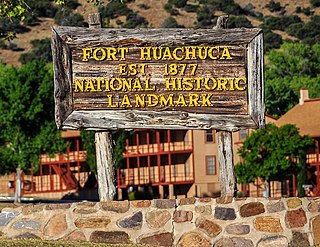
This is a list with images of some of the historic structures and places in the Fort Huachuca National Historic District in Arizona. The district, also known as Old Fort Huachuca, is located within Fort Huachuca an active United States Army installation under the command of the United States Army Installation Management Command. The fort sits at the base of the Huachuca Mountains four miles west of the town of Sierra Vista, on AZ 90 in Cochise County, Arizona.
